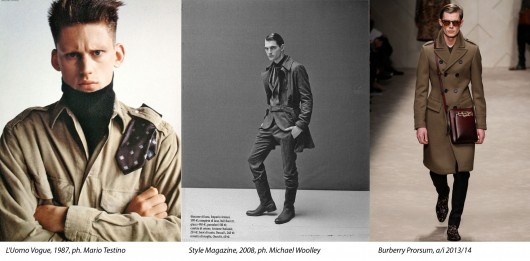ARMY GLAM
In principio furono il montgomery e l’eskimo. Il primo fu adottato dai giovani in alternativa al paletot troppo serio dei padri. Anche nei Paesi per cui, sino a pochi anni prima, il generale britannico che lo ha tenuto a battesimo era stato un nemico. In nome del nuovo, si volle dimenticare in fretta un passato recente di ostilità. La vita si faceva più veloce, il diktat del formale diventava meno imperativo. E il montgomery si rivelò perfetto per lo scooter, primo mezzo di massa per spostarsi con facilità. Il secondo fu tra gli emblemi del Sessantotto, anno di lotte, di speranze, di desiderio di libertà. Purtroppo, per molti, fu anche la divisa degli anni seguenti, ben più cupi e cruenti.
E’interessante notare come il panorama dell’abbigliamento militare abbia sempre dato spazio alla sperimentazione e all’innovazione. E non è difficile individuare le ragioni di tale fenomeno. C’erano valenze primarie da garantire: resa tecnica, resistenza, praticità, che con il mutare degli stili e dei ritmi di vita sono divenute fondamentali anche nel vestire contemporaneo. Così, nel segno di un “military hi-tech” la ricerca di comfort non si è mai arrestata. Si è sommata invece a dinamiche più specifiche dello stile civile: l’attenzione all’estetica, alla qualità, all’originalità, persino al lusso. Generando un “army glam” che ha sue costanti ben precise nel guardaroba. Come il bomber dei piloti della RAF, reso pressoché indispensabile dal trionfo globale di “Top Gun”. O gli anfibi, che altro non sono che i discendenti delle calzature indistruttibili dei soldati yankee. O come i pantaloni cargo indumento da lavoro ma anche da combattimento, con le grandi tasche laterali, in cui i guastatori tedeschi tenevano, pronto all’uso, ogni sorta di attrezzo. Senza scordare il camouflage, nato per nascondersi nella giungla e utilizzato ora invece per distinguersi nel grigiore urbano. Una decina di anni fa, un grande della nostra moda, Gianfranco Ferrè, ha chiuso la sua sfilata Uomo con una parata di parka mimetici in seta… foderati di visone.
Trasversale ad ogni tipologia, l’army glam prosegue il suo percorso. Segna, a metà anni Ottanta, la giacca-sahariana, erede dandy di quelle dell’Afrika Korps. Così come la giacca da aviatore di Emporio Armani del 2008, in pelle ammorbidita ed alleggerita che cade con facilità sul corpo. Sino al cappotto “tecnico”, anche se impeccabile nella costruzione, che Burberry Prorsum propone quest’inverno: mancano solo le mostrine sulle spalline e i gradi cuciti sulle maniche per essere quello di un ufficiale appena uscito dall’accademia… Giorgio Re
At first there were duffel coat (aka montgomery) and eskimo. The first one was adopted by kids as an alternative to their fathers’ coat. Even in countries that were submitted, a few years before, by the british general who inaugurated it. In the name of newness, a recent past of hostility was forgotten. Life was becoming faster, formal diktat less imperative. And the duffel coat revealed itself as the perfect garment for the motor-scooter, first means of transport for moving easily. The second one was among the symbols of Sixtyeight, year of fights, hope, desire of freedom. Unfortunately, it was for many people the uniform of following years, much more dark and bloody.
It’s interesting how military clothing has always given room to experimentation and innovation. And it’s not difficult to find the reasons of this occurrence. There were main needs to guarantee: technical performance, endurance, handiness, that with the style and pace of life changes have become essential in contemporary apparel. So, in the name of a “military hi-tech”, the comfort research has never stopped. It has totaled itself, instead, to dynamics belonging to civilian style: attention to appearance, quality, novelty, even luxury. The result is an “army glam” with precise features. Like the RAF pilots’ jacket, nearly essential due to the worldwide triumph of “Top Gun”. Or like combat boots, direct descendants of indestructible shoes of yankee soldiers. Or like cargo trousers, work but also combat garment, with big side pockets, used by german soldiers to keep every kind of tool ready for use. And don’t forget the camouflage, born to hide oneself in the jungle and now used to distinguish oneself from the urban greyness. Ten years ago, a big of italian fashion, Gianfranco Ferrè, closed his menswear show with a parade of silk camo parkas…fur-lined.
Army glam goes on, cross to every codification. In the mid-eighties was the turn of the bush jacket, dandy heir of Afrika Korps’ jackets. Just like the aviator jacket designed by Emporio Armani in 2008, made of soften and lightened leather, that drops easily on the body. Up to the “technical”, but flawless in cut, coat, that Burberry Prorsum propose this f/w: it is missing only military insignia and ranks stitched on the sleeves to be the coat of an official just out of the academy… Giorgio Re






